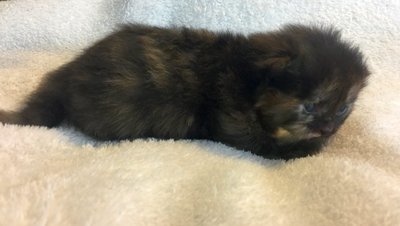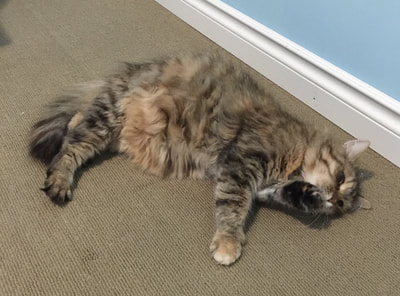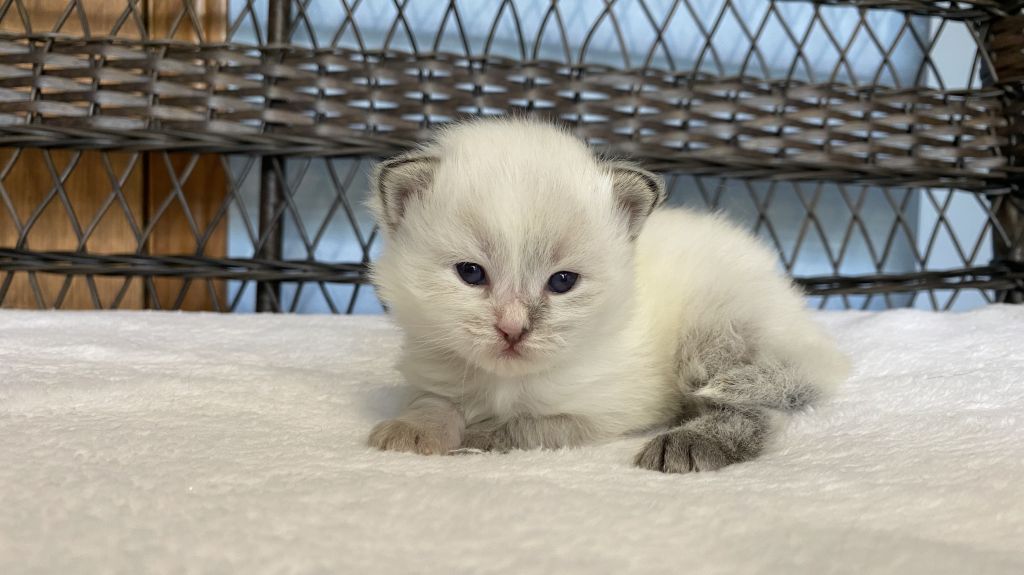Tortie is not considered a base color, but rather, it is a mix of both base colours; red and black.
Tortie typically only occurs in female cats, as they have two X chromosomes. To see more about how the heritability of the X chromosome works, see Basic Cat Genetics.
Some kittens may appear just one base (red or black), but as they grow, spots of mixed color can appear. The easiest way to identify if your kitten is tortie is by looking at their paw pads and toes. If they have a mix of pink and black toes, this means they are tortie.
When a cat has pink skin, this means that they are growing red fur; when a cat has black skin, this means that they are growing black fur. So, if your kitten has a mix of black and pink toes, your kitten will be a tortie.
Torties can have many modifiers which affect the color of the kitten, including tabby, dilute, and white. The red base can also have gold, and silver modifying it. To see examples, see silver and gold.
When you have a tortie and white, this is known as a calico cat.
Please Note:
Almost every color that is possible to produce in the Siberian Forest cat is listed, however, some are difficult to identify.
If we, at DevinePaws, have not produced a particular color, we have found pictures from the internet with watermarks where possible. All pictures on this site are copyright and not to be used without permission.
Black Tortie Self (solid)
Solid is a recessive gene. This means that your kittens parents do not need to be solid to produce a solid kitten.



Black Tortie PawPeds EMS: f
Torbie (Tortie with Tabby)
When a tortie kitten has the tabby gene (Agouti A Locus), it is known as a torbie. A torbie can be any tabby marking; mackerel (Mc), classic (mc1), ticked (ti+) or spotted. To see more information about tabby markings, see Tabby Coat Markings.


Torbie with Classic tabby PawPeds EMS: f 22



Torbie with Mackerel tabby PawPeds EMS: f 23
Torbie with Spotted tabby PawPeds EMS: f 24
Blue Cream (Dilute)
Dilute is a recessive gene. This means that your kittens parents do not need to be dilute to produce dilute kittens.
Dilute will change your kittens black areas to blue (grey) and the orange areas to cream (light orange)
Blue Tortie (solid)
A blue tortie self is a tortie cat which inherited the dilute modifier and the solid modifier. Both of these modifiers are recessive, which means their parents do not have to be solid or dilute to produce blue tortie solids.
Blue Tortie PawPeds EMS: g
Blue Torbie (Tortie with tabby)
A blue tortie tabby is a kitten which inherited the dilute modifier as well as the tabby modifier.
Blue Torbie Classic Tabby PawPeds EMS: g 22
Blue Torbie Mackerel Tabby PawPeds EMS: g 23
Blue Torbie Spotted Tabby PawPeds EMS: g 24
Point (NEVA)
The pointed gene is recessive. This means that your kittens parents do not need to be point to produce a pointed kitten.
It can be difficult to determine if your kitten is a pointed tortie because the point gene acts as a mask and hides most of the coat color. The easiest way to determine if your pointed kitten is a tortie is by looking at their paw pads.
Seal Tortie Point
A seal (seal = black) tortie point is a pointed kitten which is a tortie kitten with only NEVA modifying the coat color.
Your kittens ears, legs and tails will be a mix of black and red.



Seal Tortie Point PawPeds EMS: f 33
Seal Tortie Lynx Point
A seal (seal = black) tortie lynx point is a pointed kitten which is a tortie kitten with tabby (lynx = tabby) and NEVA modifying the coat color.
Your kittens ears will be a mix of red and black, and the legs and tail will be red and black with stripes.



Seal Tortie Lynx Point PawPeds EMS: f 21 33
Blue Tortie Point
A blue tortie point is a pointed kitten which is a tortie kitten with both dilute and NEVA modifying the coat color.
Your kittens ears, legs and tails will be a mix of blue and cream.
Blue Tortie Point PawPeds EMS: g 33
Blue Tortie Lynx Point
A blue tortie lynx point is a pointed kitten which is a tortie kitten with tabby (lynx = tabby), dilute, and NEVA modifying the coat color.
Your kittens ears will be a mix of cream and blue, and the legs and tail will be cream and blue with stripes.
